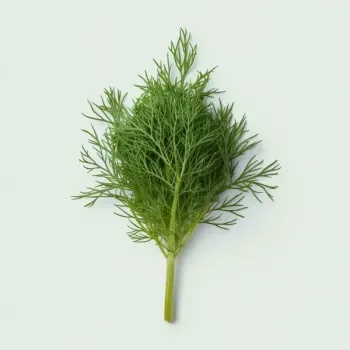Dill and basil are aromatic herbs used in cooking for their distinctive flavors. Dill has a grassy taste with a hint of licorice, ideal for pickling and fish dishes. Basil offers a sweet, peppery flavor with mint notes, commonly used in Italian cuisine and pesto.

Dill is an aromatic herb with feathery green leaves. It is known for its distinctive taste that is somewhat grassy with a hint of anise-like licorice. It's commonly used in European and Asian cuisines, and both its leaves and seeds are used in cooking.

Basil is a fragrant herb with a sweet, peppery flavor and is a staple in Mediterranean cuisine, particularly Italian dishes. It has a warm, spicy taste with a trace of mint and clove. Basil is typically used fresh in recipes and is a key ingredient in pesto.
Dill has a delicate, feathery texture and a fresh, grassy taste with a hint of licorice. Basil leaves are more robust with a smooth texture, offering a sweet and spicy flavor with notes of mint. The two herbs offer distinctly different flavor profiles which may not be interchangeable in recipes.
Dill is commonly used in pickling, salads, and with fish dishes. Basil is more versatile in Mediterranean cooking, featured in tomato-based dishes, pesto, and as a fresh garnish.
Dill has a strong presence in Eastern European and Scandinavian cuisines, whereas Basil is more central to Italian, Mediterranean, and Southeast Asian cooking.

Your ultimate Recipe Box, Meal Planner, and Cooking Class all in one
Dill is the traditional herb for flavoring pickles. Its seeds and fronds impart a tangy flavor that is essential for dill pickles. Use whole sprigs when pickling for a more balanced infusion of flavor. Basil is less common in pickling but can be used for a unique twist. Sweet basil can complement the acidity of pickled vegetables with its subtle, peppery notes.
Dill is excellent in salads that feature fish, potatoes, or cucumbers. It adds a refreshing, clean taste. Finely chop the dill and sprinkle it in for a burst of flavor. Basil shines in tomato-based salads, such as Caprese, and pairs well with fresh mozzarella cheese. Tear basil leaves by hand to release their aromatic oils without bruising the herb.
Dill sauce is often served with fish, particularly salmon. It provides a zesty, tangy complement to creamy sauces. Mix chopped dill into mayonnaise or yogurt for an easy sauce. Basil is the star of pesto and is also excellent in marinara and tomato sauces. Its sweet and spicy profile enhances the natural acidity of tomatoes. Blend fresh basil into sauces at the end of cooking for maximum flavor.
Dill is commonly used in soups such as borscht or potato soups in Eastern European cuisine, where it adds a complex layer of flavor. Add it towards the end of cooking to preserve its delicate taste. Basil complements soups that have a tomato base, like minestrone or tomato bisque. It can be added fresh or as part of a bouquet garni during simmering to infuse the soup with its aroma.
Both dill and basil are low in calories and rich in vitamins and minerals. They contain various antioxidants and have health benefits when included in a regular diet.
| Nutrient | Dill ( per 100 grams ) | Basil ( per 100 grams ) |
|---|---|---|
| Fat | 1.1g | 0.6g |
| Sodium | 61mg | 4mg |
| Calcium | 208mg | 177mg |
| Protein | 3.5g | 3.2g |
| Calories | 43 | 23 |
| Carbohydrates | 7g | 2.7g |
Substituting basil for dill in a dill pickle recipe would significantly alter the traditional flavor. While it's possible, it would create a different type of pickle.
Dill is traditionally preferred for fish dishes due to its light and tangy flavor that complements the delicate taste of fish.
While you can make a herb-based sauce with dill, it would not be considered traditional pesto. The flavor profile would be quite different from basil pesto.
Dill and basil can be used interchangeably in some salad recipes, but the flavor of the salad will change significantly. It's best to choose the herb that complements the other ingredients in the salad.
Fresh dill can be wrapped in a damp paper towel and stored in the refrigerator. Basil is best stored at room temperature in a cup of water, like a bouquet of flowers, to prevent wilting.